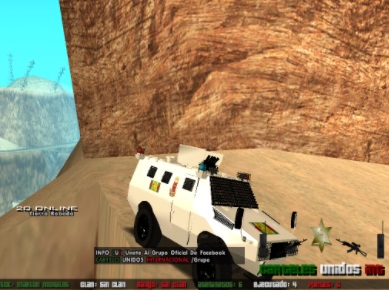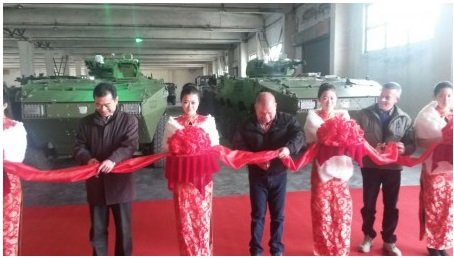The Toys of Repression
The Venezuelan government has spent big money on tanquetas, murciélagos, ballenas, armored personnel carriers and anti riot tear gas cannisters. Here's the rundown.


Military-style gear is one thing the regime’s never scrimped on. The trend started by Hugo Chávez in 2005 renewed Venezuela’s military gear, supposedly to prepare for battle against the countless imaginary enemies chavismo created through the years. But really, we always knew who the real target was, because it stared back at us from the mirror each morning.
Initially, the Chávez administration sourced its war toys from traditional suppliers like the United States. But after 2006, when an embargo on military material was applied to Venezuela, Chávez started asking his friends from the East for guns. First it was Russia, later China. Some of these contracts were, ironically, signed by then-Defense Minister, Raúl Baduel; today one of Maduro’s highest profile political prisoners.
Let’s get something straight: the Government spent at least $500 million, plus God knows how many oil barrels, to give a Chinese company the chance to try its little war toys on Venezuelan protesters.
Even as the economic crisis hit hard, forcing the Maduro government to reduce its military expenses —by more than 90% compared to the Chávez years, according to some NGOs, — they continued the “Eternal Commander’s” tradition. That’s why, in a country where food and medicines are nowhere to be seen, there’s a squad of armored personnel carriers (APCs), fully equipped with tear gas canisters and rubber pellets, waiting for every march and protest to reach them.
Armored Vehicles: APC’s (a.k.a., “Tanquetas”)
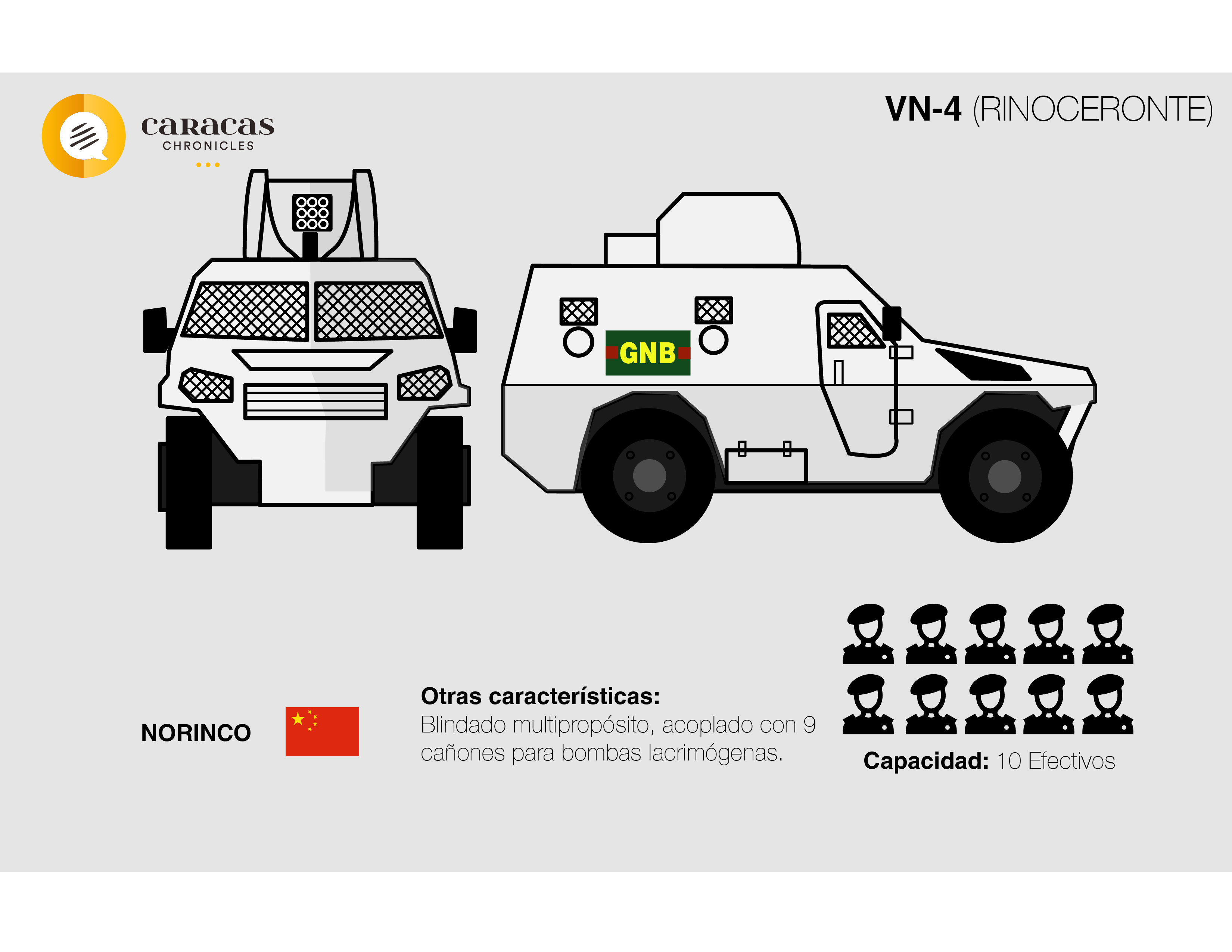 If you’ve taken part in any of the countless demonstrations that have taken place in Venezuela since La Salida, then you’ve seen one of these little white monsters. People call them “rhinos” or tanquetas — but that’s a bit of a misnomer. A vehicle would have to have a gun turret to qualify as a combat-ready tanqueta.
If you’ve taken part in any of the countless demonstrations that have taken place in Venezuela since La Salida, then you’ve seen one of these little white monsters. People call them “rhinos” or tanquetas — but that’s a bit of a misnomer. A vehicle would have to have a gun turret to qualify as a combat-ready tanqueta.
Its official designation is the VN-4 armored vehicle, manufactured in China by the Chinese Defense Company, NORINCO. Unlike most people tend to think, they are quite modern and versatile, able to carry two drivers and up to eight soldiers inside, reaching up to 115 km/h and being able to go for about 700 km. without refueling.
VN-4s can do a lot of damage. The original, warfare-oriented units have a central turret that is usually armed with a 7,5 mm. heavy machine gun. The units deployed in Venezuelan protests, however, have been modified for riot-control purposes with the machine gun being replaced for a more “friendly” tear-gas launcher. The little white beasts can also be equipped with several Bond-like gadgets, including an infrared night-vision system and a central tire inflation system that prevents them from being disabled by a flat tire. These perks, however, are optional, and we doubt if Baduel sprung extra for those.
You sometimes get the sense we’re the guinea pig Chinese weapon manufacturers are using to show the world how efficient their toys are.
Out of the 224 VN-4’s that China has officially exported worldwide, 194 were bought by the Venezuelan government and distributed mainly to the GNB. 121 of them were bought in 2012, while the rest were ordered after the 2014 protests.
Kenya, a country actually fighting real terrorists in their border with Somalia, bought the remaining 30.
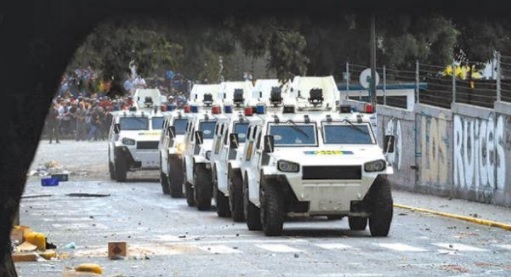 The VN-4s are already an iconic image of repression against opposition demonstrators. These things are now so popular around the country that there are even mods to use them in Grand Theft Auto video games.
The VN-4s are already an iconic image of repression against opposition demonstrators. These things are now so popular around the country that there are even mods to use them in Grand Theft Auto video games.
One of the perks of having a millennial core of protesters, I guess.
Murciélagos
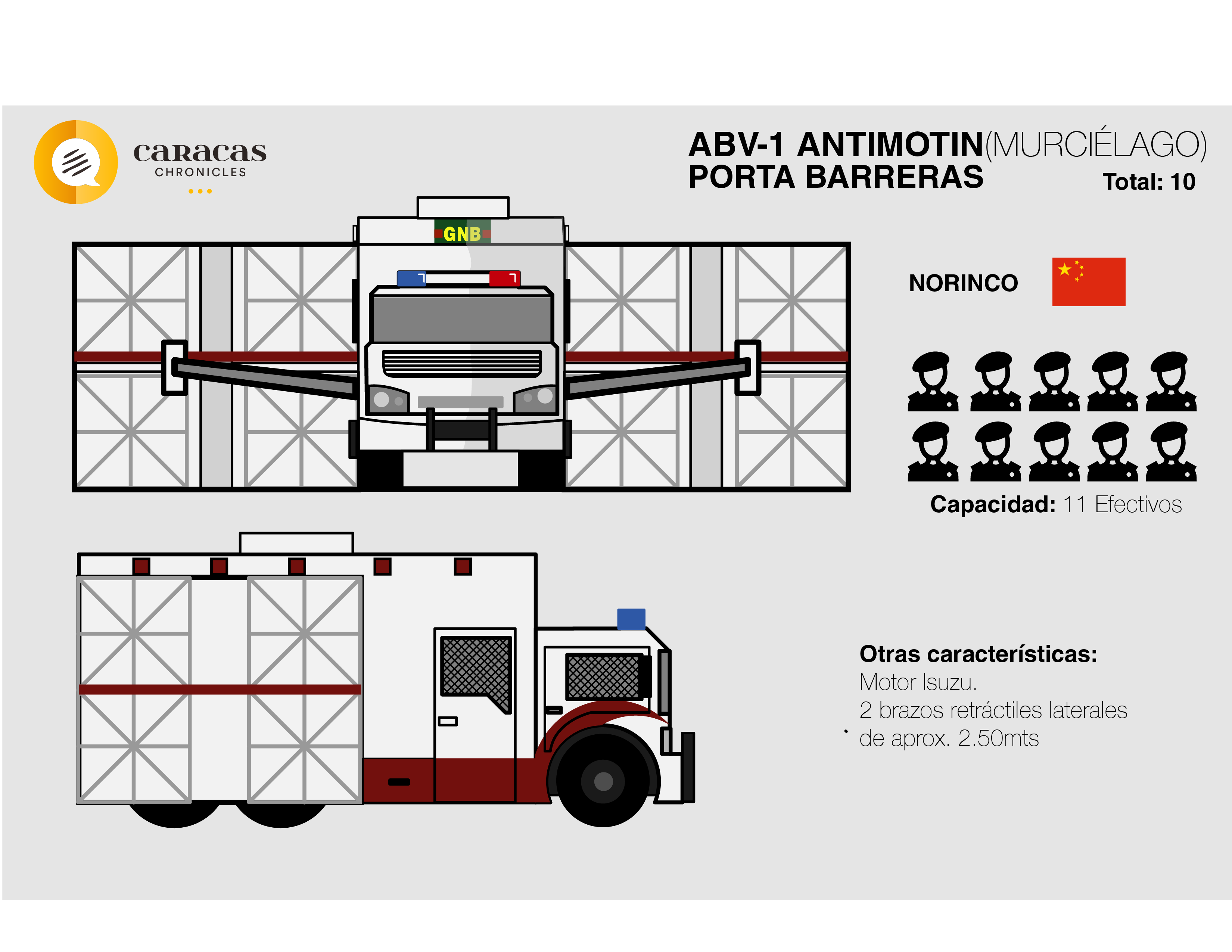 The ABV-1, better known as el murciélago (“the bat”) is a really peculiar vehicle. It was named after bats because of their two “wings” —a pair of about 3-meter tall barriers that can be deployed laterally from both sides of the truck, creating a cover for officers behind them and solidly blocking people from going beyond a certain point.
The ABV-1, better known as el murciélago (“the bat”) is a really peculiar vehicle. It was named after bats because of their two “wings” —a pair of about 3-meter tall barriers that can be deployed laterally from both sides of the truck, creating a cover for officers behind them and solidly blocking people from going beyond a certain point.
In Caracas, they have been used to literally divide the city in half.
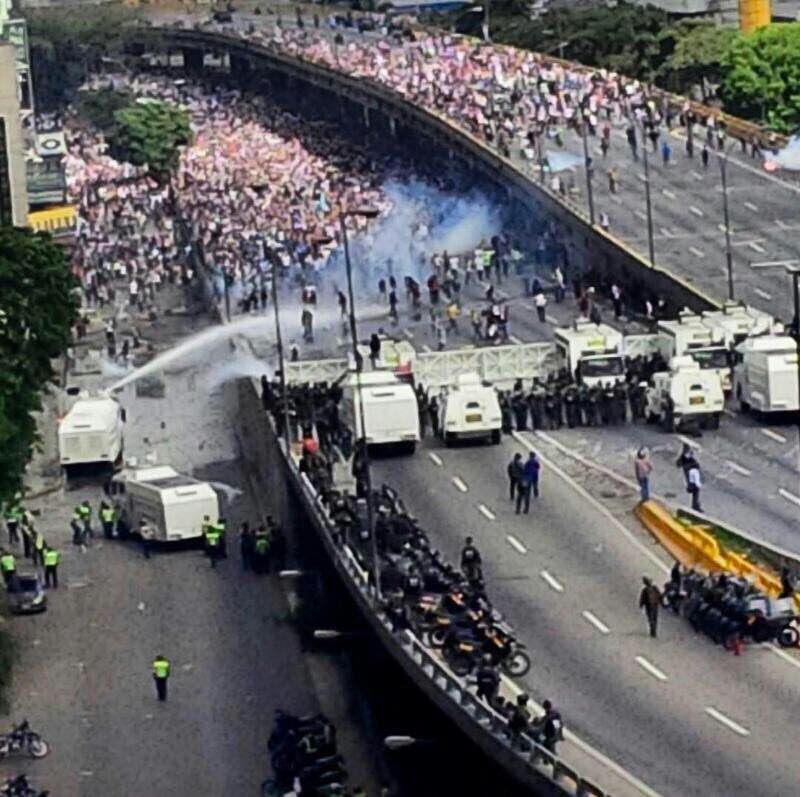 Only ten of them were originally bought from NORINCO in 2012. They seem to be primarily deployed in Caracas, a city with great highways that can’t be efficiently blocked by men alone. Murciélagos have been used in some other cities too: I saw one in the 2013 protests in Mérida following Nicolás Maduro’s victory over Henrique Capriles.
Only ten of them were originally bought from NORINCO in 2012. They seem to be primarily deployed in Caracas, a city with great highways that can’t be efficiently blocked by men alone. Murciélagos have been used in some other cities too: I saw one in the 2013 protests in Mérida following Nicolás Maduro’s victory over Henrique Capriles.
Unlike most people tend to think, they (tanquetas) are quite modern and versatile, carrying two drivers and up to eight soldiers inside
Almost two weeks ago we got to see how the GNB used the bat’s walls as cover to ambush protesters.
Remember Freddy Guevara’s already famous video in which he lent his parliamentary immunity to an almost-captured protester by hugging him while some GNBs tried to separate them? It all happened right in front of a couple of these things.
We could find no records of the ABV-1 being used in any other country for riot control. In fact, we couldn’t even find it in NORINCO’s catalog. It seems to be a Solo en Venezuela type deal. In fact, you sometimes get the sense that we’re the guinea pigs Chinese weapon manufacturers are using to show the world how efficient their toys are when it comes to stopping people from exercising their civil rights.
As expected, with a vehicle not extensively sold in international markets, specs for the “bat” are shady. A similar Slovak model, the Bozena Riot, has been more popular, mainly in Africa and Eastern Europe, and since they seem to be quite similar, some of their capabilities might be comparable. The Bozena is quite a beast, able to deploy a 3 meter-high, fire retardant wall that can shield up to 36 men.
Ballenas
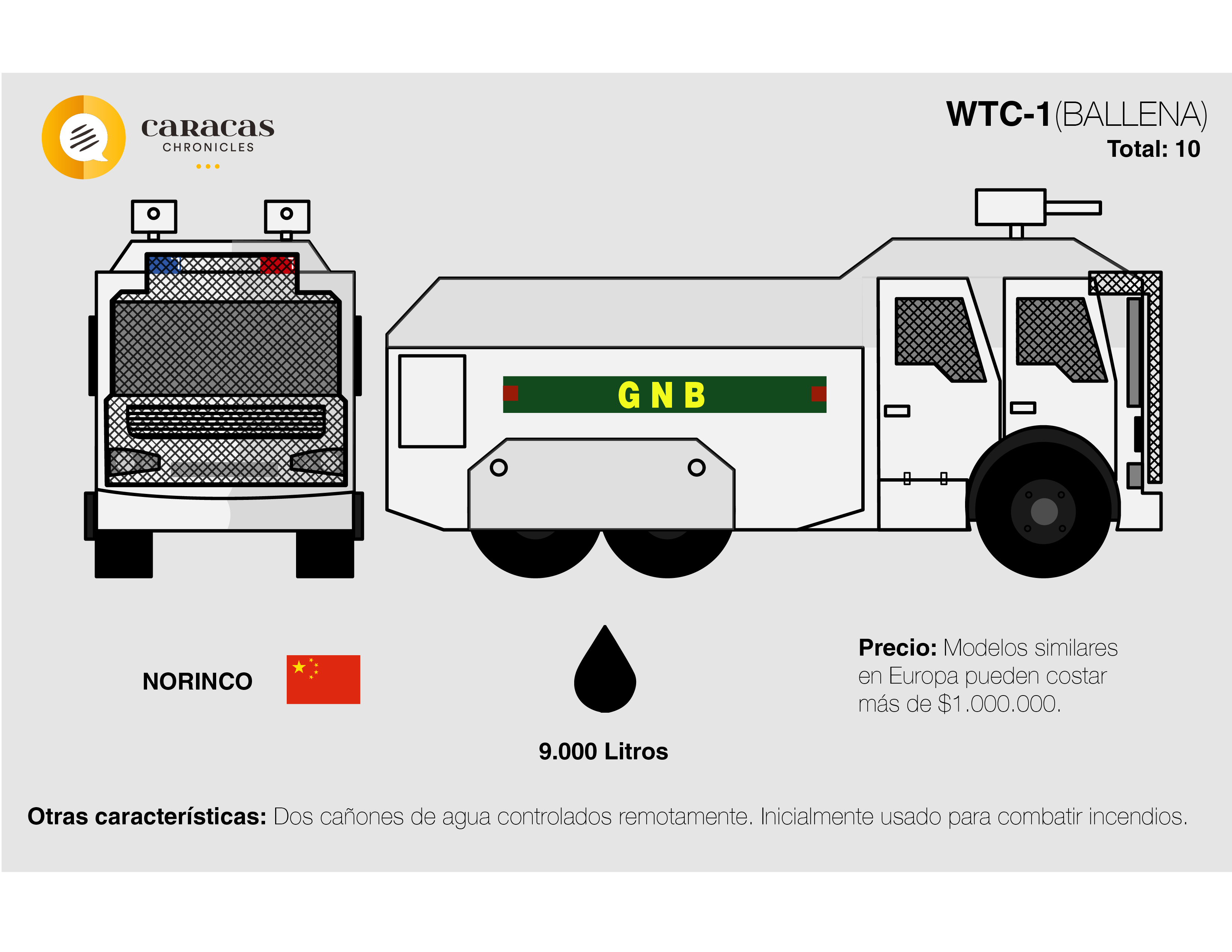 Water cannon trucks, or “whales,” are one of the most storied machines of riot control. Unlike the “bat,” they’ve been around since the 1930s, widely used around the world. They became infamous during the American Civil Rights Movement in the 60s. They are no less new in Venezuela; police forces have been using them for quite a long time, even before chavismo’s rise to power. Their usage, however, has been dramatically reduced lately in most parts of the world, mainly because under certain circumstances, they may cause death or severe trauma.
Water cannon trucks, or “whales,” are one of the most storied machines of riot control. Unlike the “bat,” they’ve been around since the 1930s, widely used around the world. They became infamous during the American Civil Rights Movement in the 60s. They are no less new in Venezuela; police forces have been using them for quite a long time, even before chavismo’s rise to power. Their usage, however, has been dramatically reduced lately in most parts of the world, mainly because under certain circumstances, they may cause death or severe trauma.
Venezuela bought 10 of these things a few years ago from —who else?— China. The model is NORINCO’s WTC-1 and most units are also currently deployed in Caracas. Now, 10 water cannon trucks might not seem like much of a threat, but countries like the UK have only six of them and strict limitations restrict their use. As with most of the Government’s deals, the price of these trucks is unknown, but similar versions might cost as much as 1 million USD in Europe.
Most of these (tear gas) bombs were bought from Brazilian company Condor Tecnologias Não Letais, mainly between 2002 and 2011.
The WTC-1 is a really big truck, with an equally big tank capable of carrying 9,000 liters ,which guarantee a water flow that’s way more reliable than most Venezuelan homes. Bought in 2012, along with the first VN-4s and ABV-1s, before social unrest became an everyday thing in Venezuela, whales were initially used to help firefighters battle wildfires that spread around Caracas during the yearly dry season. In 2014, their value as riot gear was finally tested. The results since then have been quite satisfying for the government, as you have probably seen by now.
Where do these tanks come from?
The checks these toys were paid with were written to NORINCO: the China North Industries Corporation. Founded in 1980, it has become one of the most valuable state-owned industries in China, with 276,000 employees (that’s almost as many people as my hometown, by the way) and yearly revenue of $64.4 billion in 2014.
NORINCO is sometimes described as China’s most advanced defense manufacturer, able to build anything from lasers and radar waveguides to tanks and anti-aircraft artillery.
In 1993, after China’s permanent normal trade relations with the United States were established by the Clinton administration, a ban was imposed on NORINCO’’s armor and weapon imports to “The Empire,” eventually resulting in investigations into many of the company’s US-based importers and contractors. Trade relations with the US further deteriorated in 2003 when the Bush administration imposed several sanctions against the company for allegedly selling missile-related equipment to Iran.
Any problem NORINCO may have had with US customs authorities, the Venezuelan government didn’t give a shit about, and, in 2012, under Hugo Chávez’ rule, the FANB signed a $500 million contract with the Chinese weapons manufacturer, and procured most of the armored vehicles currently being deployed by the GNB and other branches of the armed forces.
They even got Chinese girls wearing traditional qipaos when some of the armored vehicles were delivered in 2014.
Economic relations between both institutions were eventually strengthened on August 2013, when the Venezuelan Anonymous Company of Military Industries (CAVIM under its Spanish acronym) signed a cooperation agreement for military development.
Let’s get something straight: the Government spent at least $500 million, plus God knows how many oil barrels, to give a Chinese company the chance to try its little war toys on Venezuelan protesters.
Tear gas and anti-riot gear
Tear gas canisters have been a constant in every single protest currently taking place in Venezuela. Thousands of them have been used by the GNB and PNB to disperse demonstrators.
Most of these bombs were bought from Brazilian company Condor Tecnologias Não Letais, mainly between 2002 and 2011. No register of these transactions has ever been presented in any of the accountability reports of neither Defense, nor Interior Ministries. The National Statistics Institute (INE for its Spanish acronym) reports indicate that the value of these transactions reached little more than 2 million dollars, but those from Brazilian Institutions indicate that the real value of these contracts may have been around 10 million dollars. Only during 2008 and 2011, Condor exported more than 140 tons of pellets and tear gas canisters to more than 40 countries, Venezuela being one of its main buyers.
Countries like the UK have only six of them (ballenas) and strict limitations restrict their use
About 60% of canisters collected form 2014 protests at the Universidad Central de Venezuela (UCV) main campus in Caracas, and several protest sites in the province were manufactured by Condor, the other 40% were produced by joint projects between CAVIM and other foreign companies.
Most of those canisters were labelled by Falken S.A, a Spanish company not appearing in any public document registering contracts signed by Venezuela. Spain was for years one of Venezuela’s main anti-riot gear providers, but exports to our tropical nation were later reduced as Spain refused to keep selling this kind of material to the Venezuelan Government after the brutal repression seen during 2014 protests, this along with the impact that the ongoing economic crisis has had on imports as a whole, might help explain why most canisters used during the last few weeks protests are long expired.
Protective gear for military and police officers has also represented an important import during the last years, especially after the 2014 events. Only that year, the Venezuelan government ordered NORINCO 18.000 units of their so called “Robocop” armors. The total cost of that operation is also unknown.
Caracas Chronicles is 100% reader-supported.
We’ve been able to hang on for 22 years in one of the craziest media landscapes in the world. We’ve seen different media outlets in Venezuela (and abroad) closing shop, something we’re looking to avoid at all costs. Your collaboration goes a long way in helping us weather the storm.
Donate


